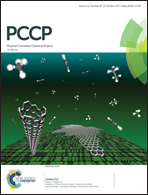First-principles investigation of H2S adsorption and dissociation on titanium carbide surfaces†
Abstract
The adsorption and dissociation reactions of H2S on TiC(001) are investigated using first-principles density functional theory calculations. The geometric and electronic structures of the adsorbed S-based species (including H2S, SH and S) on TiC(001) are analyzed in detail. It is found that the H2S is bound weakly, while SH and atomic S are bound strongly on the TiC(001) surface. The transition state calculations show that the formation of SH from H2S (H2S → SH + H) is very easy, while the presence of a co-adsorbed H will inhibit the further dissociation of SH (SH + H → S + H + H). In contrast, the hydrogenation of the adsorbed SH is rather easy (SH + H → H2S). Therefore, the dissociative SH can be removed via the hydrogenation reaction. It is concluded that it is difficult for H2S to dissociate completely to form atomic S and poison the TiC surface. The results will further provide understanding of the mechanism of the sulfur tolerance of the TiC anode of proton exchange membrane fuel cells (PEMFCs).



 Please wait while we load your content...
Please wait while we load your content...